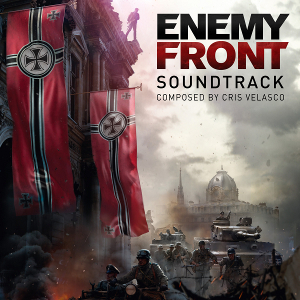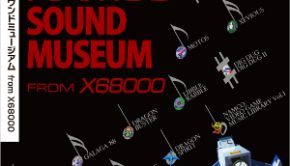Enemy Front Soundtrack
 |
Album Title: Enemy Front Soundtrack |
| Record Label: Namco Bandai Games (Physical Edition); Sumthing Else Music Works (Digital Edition) |
|
| Catalog No.: N/A |
|
| Release Date: June 10, 2014; June 13, 2014 |
|
| Purchase: Download at iTunes |
Overview
Enemy Front, developed by CI games and published by Bandai Namco, was not met with the best reception. Its disappointing graphics and numerous gameplay flaws kept it from being seriously noticed in the gaming world upon its release, which is unfortunate. As mediocre as the game might have been, Cris Velasco’s score was powerful and rather unusual for a war game, let alone a FPS. Velasco worked with composer Sean Hathaway, a freelance composer who worked previously with Velasco on the score to Company of Heroes 2 (with an equally impressive result). The first solo work of Velasco’s I experienced was the Company of Heroes 2 soundtrack, during which I was amazed by how much I loved the music. Being partial to fantasy RPGs, the game was not my usual style, and I expected the music to be similar: harsh, tense, dramatic, and few themes to follow throughout the score. I was pleasantly surprised at the gorgeous choir and string instruments used in the score, and the somber, proud melody introduced in the opening song. Before listening to the Enemy Front music, I found myself wondering how this would compare: was Company of Heroes 2 a one-time hit, or had I only caught a glimpse of Velasco’s style in that album? The answer was neither.
Body
The titular title theme begins with the dark, ominous strings typical of most realist war games, rising to a few triumphant chords; however, halfway through the piece, I was startled at hearing a sweet, sorrowful piano melody. My first thought was that Velasco and Hathaway had instantly added several dimensions to the score. Yes, as illustrated in the first half of the track, this would be a war game, with drama, action, and death; but the second half illustrated emotion, and I realized that I wasn’t just eager to hear the rest of the soundtrack, but actually curious to see the direction the soundtrack would go in. “This is Warsaw Calling” brings the piano back again with the same melody as “Enemy Front,” this time in a higher key, and met with strings alternating between octaves. Like “Enemy Front,” the piece begins in a more military fashion, this time with a march rhythm, including a snare drum, followed by a single trumpet belting out a hint of a motif, just enough to be militant, before the piano enters and takes over. Pieces like this in games like Enemy Front are, to me, daring, and a little risky. They’re certainly not typical of FPS games, and certainly the music shouldn’t detract from the mood of the game. However, the way “Warsaw Calling” is incorporated into the game, it brings a third dimension to an action-packed game.
While extraordinarily short, “Remembrance” is among the best tracks on the album. The piano returns, accompanied by harp and a gentle cello soli. The track is extraordinarily short, with the melody repeating two times, broken by a temporary modulation before leaping up a few octaves. Other pieces incorporate the piano in a more dramatic way; “Lateral Movements” pits the piano and harp against staccato strings before falling into a walking rhythm with the occasional broken quarter notes keeping the piece moving. It doesn’t quite have a melody, but it functions well as quintessential soundtrack fare, as background music that keeps the pace of the game while adding interest. “The Storm” brings a variation to the theme in “Enemy Front” and “Warsaw Calling,” but this time an action-packed variation, with the piano serving as one of the many instruments in the string-and-brass duet, instead of the solo. The piece is by no means soft, but neither is it harsh and dissonant like “Stick to the Shadows”; it is dramatic and melodic and harmonic with some rise and fall as the piece concludes. This is one piece I would have liked to see extended; it works as a fantastic variation on the main theme of the game, and extends the action without becoming monotonous.
“Warsaw Uprising” is is what I expect to find in a World War II FPS: a fast piece of dissonance, patterned rhythms in low strings, and slow melodies in the low bras. There is nothing wrong with the stereotypical approach. Like any medium of storytelling, the audience likes to know what’s going on. In a violent game, I expect dramatic music. I want my blood to be rushing at the most action-filled scenes, and my heart to be pounding during the stealth scenes. If that’s not happening, then something is wrong with the game. “We Don’t Need Another (Dead) Hero” uses a rising progression to reach a bright and energetic sequence with the unusual combination of brass and piano. “Tanks for the Memories” uses with a dotted rhythm, slightly uncharacteristic in this score, modifying the typical battle/action music pattern, while bringing a variation of the main theme again to the game.
The soundtrack is not all high points. “Vigilant Preparations” is one of the few pieces of this track that seem to be mostly filler music, containing long, drawn-out chords, and repetitive progressions, while “Quiet as a Mysz” opens with the piano but quickly falls into an aimless melody. “Stick to the Shadows” meanwhile is a stereotypical stealth piece; lacking any serious melody, but full of held-out dissonant notes and irregular tattooed eighth notes outlining minor arpeggios. It’s not among the most entertaining on the album, but does work successfully in context. Luckily, this is not the norm on this album; most of the pieces that I found easy to forget were mostly so because of the surrounding pieces. Thankfully, the likes of “Remembrance” adds another element to the soundtrack that couldn’t exist with only tracks like “Warsaw Uprising” and “Stick to the Shadows.”
The soundtrack ends with “A Story of Resistance,” a five-minute long variation to the piano melody in “Enemy Front.” A soundtrack’s conclusion is vital to leaving a lasting impression on the audience; had this album ended with another action piece, I might have passed it by with less notice, despite the intriguing opening motif. However, the fact that Velasco and Hathaway chose to end it on a note like “Resistance” leaves me with a more thoughtful impression of the game. The piano comes and goes with a three-note arpeggio in 12/8 time, opening with an impossibly gentle trumpet counter-melody. The piano disappears as some heavy strings enter with a few sentences of music, fading away slightly as a bassoon then takes over. The fluidity between instruments in this track lends itself to a more thoughtful and tender melody. Eventually the bassoon ends on a question note, and piano returns with a more definitive melody, maintaining the same dynamic — as pianissimo as possible — while bringing in added notes, ornaments, and octaves. A cello enters just as the piece begins to fade, and over the course of a minute, the two instruments embark on the slowest decrescendo imaginable until they resolve together, concluding the soundtrack.
Summary
Enemy Front is an action game, and it is hard to criticize an action game for having too much action in the score. But it’s also difficult to overlook such incredible versatility in a soundtrack that could have easily been written dismissively, as a side note: a rote dramatic theme, high brass and low percussion, with the occasional interval of dissonant strings. Instead, Velasco and Hathaway, like they did for Company of Heroes 2, seem to have tackled this project head-on, with serious enthusiasm. The resulting soundtrack is fascinating. I continuously wonder what’s going to happen next, where the next, or current, track is heading, and where I’m going to hear my favorite themes again. Though there were a few stereotypical or brief tracks here, I found myself generally engaged in the score on a level that doesn’t happen often. I said this before when listening to Company of Heroes 2, and I am glad to say it again: I will be very interested to listen to Velasco’s next scores, and look forward to following his future compositional work. This particular soundtrack can be purchased through Sumthing’s digital catalog and was also packaged with the special edition of the game.
Do you agree with the review and score? Let us know in the comments below!
3.5
Posted on July 27, 2014 by Emily McMillan. Last modified on July 27, 2014.














